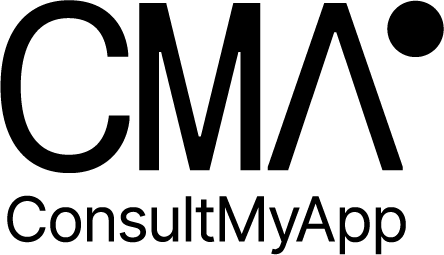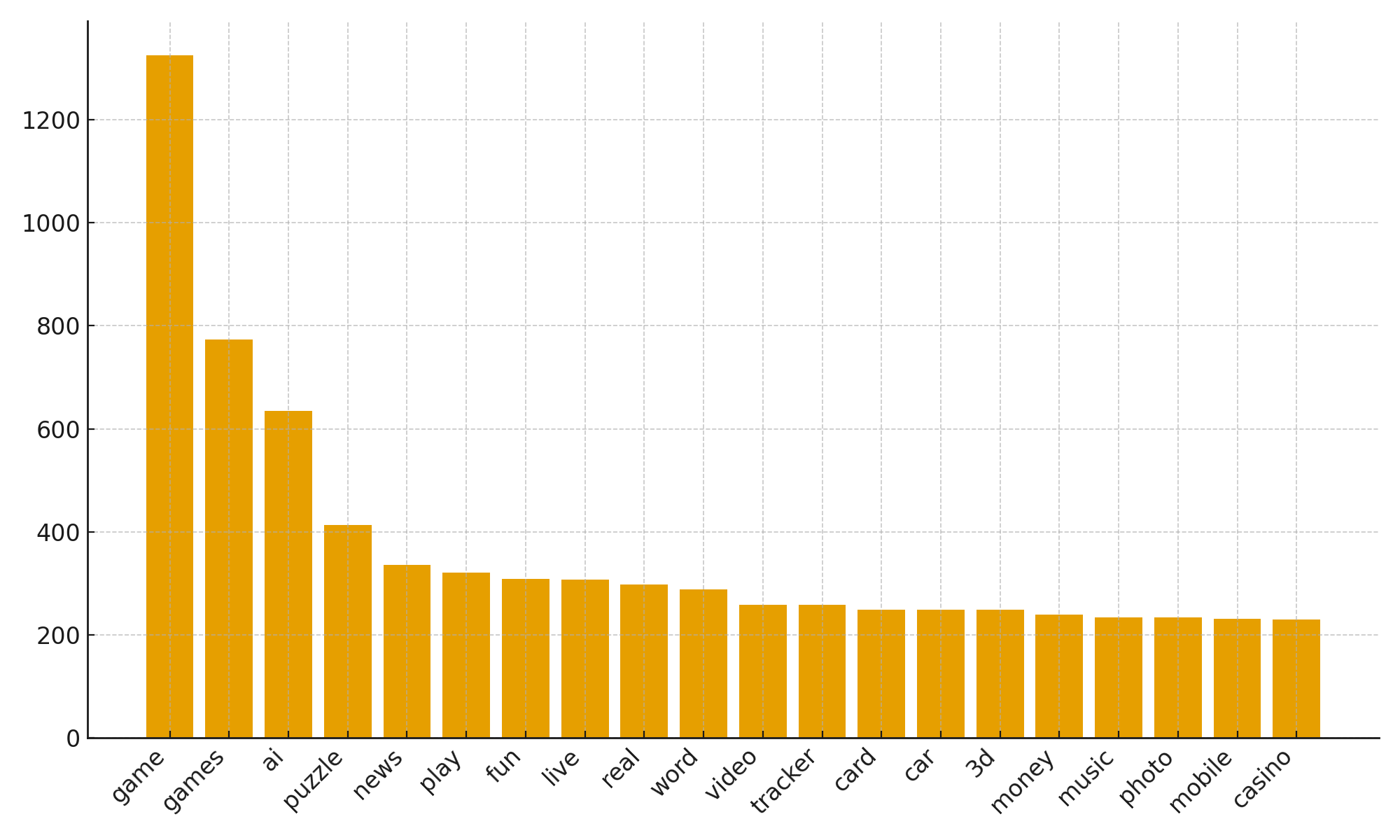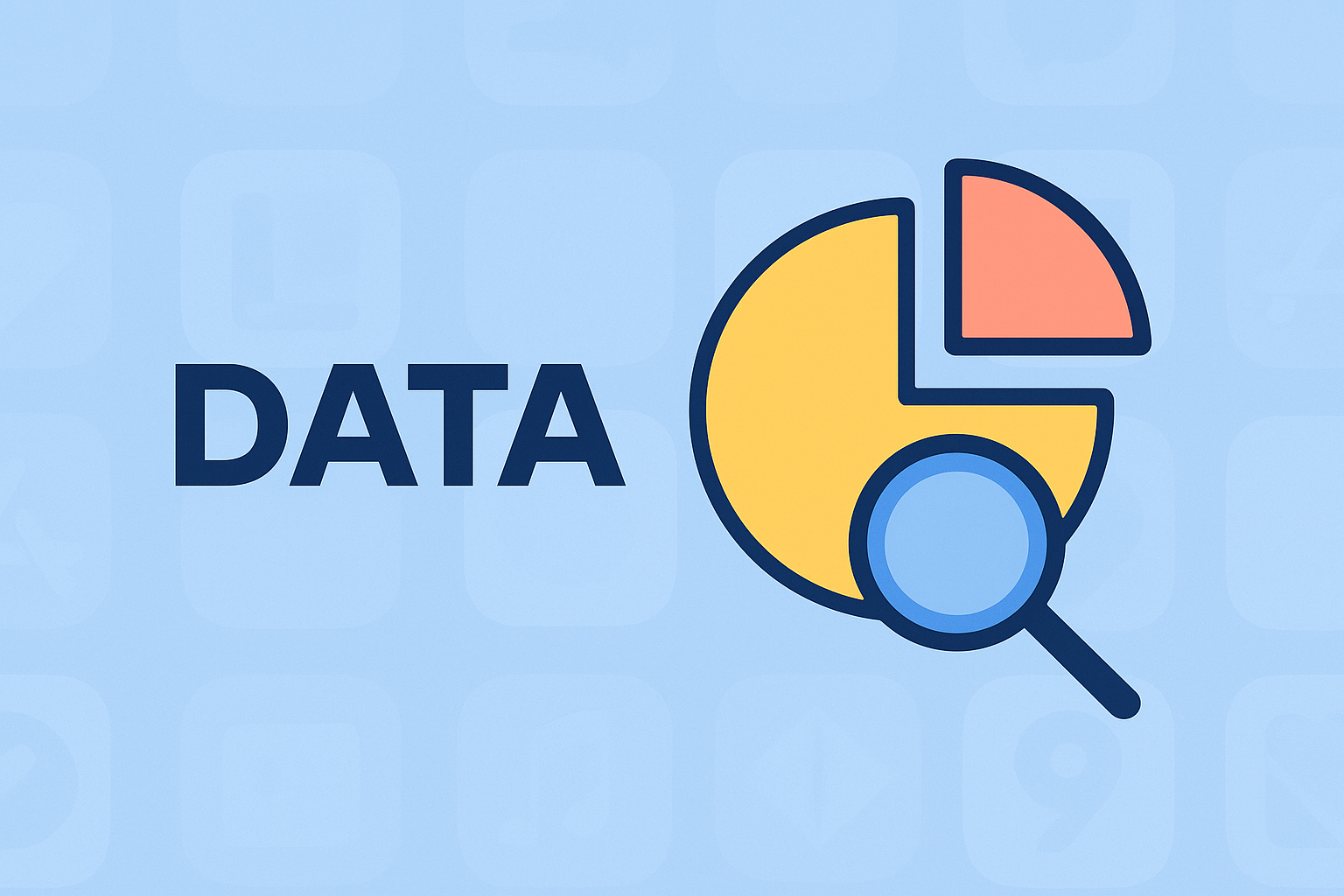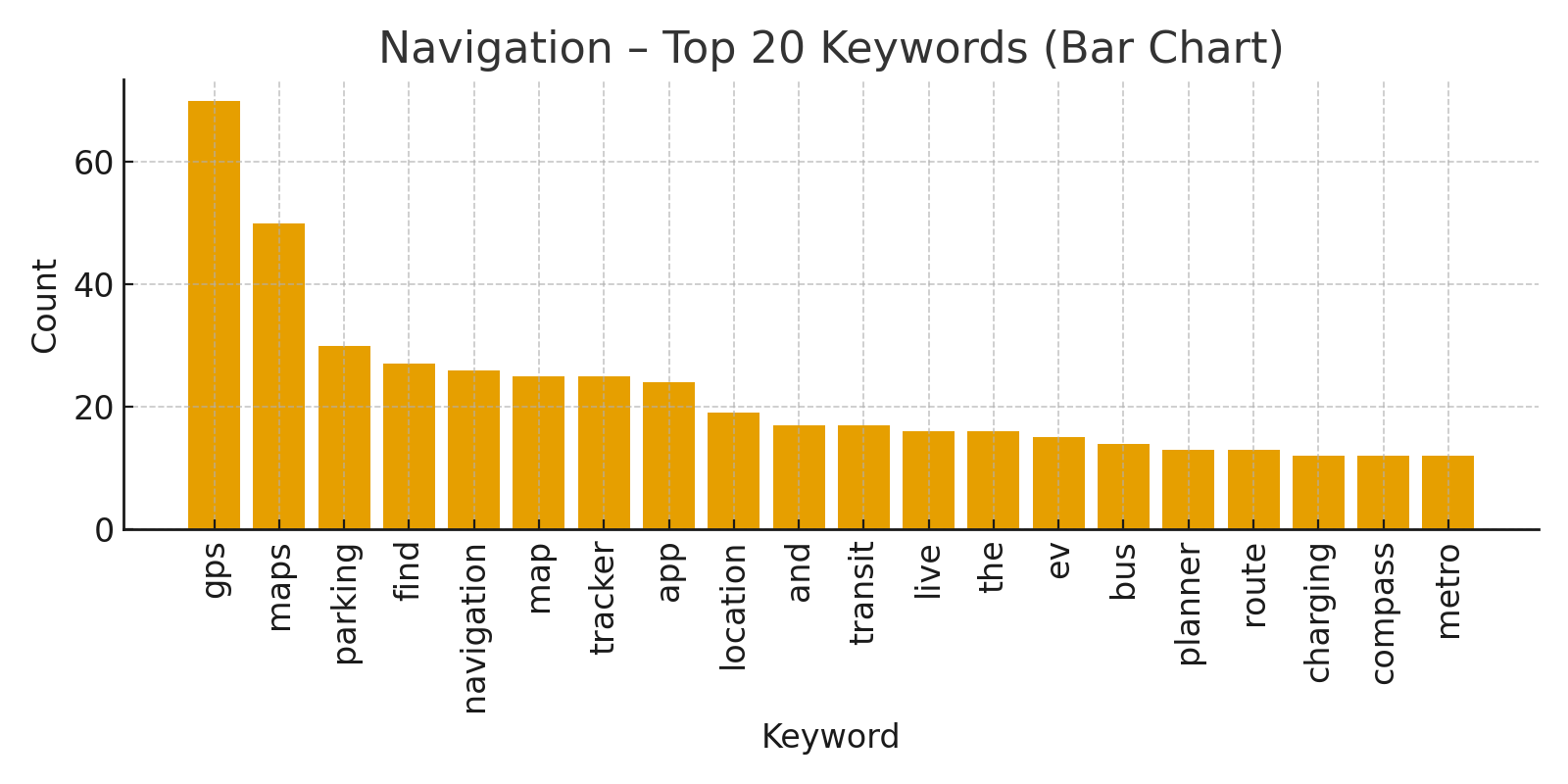🌟 App Store Keywords – Full Data & Analysis of 7,500 Apps Across Every Category in the US App Store (Nov 2025)
👋 Introduction: Why App Store Keywords Still Matter
As we head into 2026, the App Store is louder, faster, and more competitive than any time in its history. With millions of apps fighting for attention, App Store keywords are still one of the most powerful levers of visibility — yet also one of the most misunderstood. Keywords and copy no longer provide just lexical indexing, they also shape the meaning & purpose of an app which influences Apple’s semantic indexing for those valuable terms - even if you don’t explicitly mention them!
To finally bring clarity, we analysed the top 250 apps in every single App Store category — that’s 7,500 apps — using live data extracted through APPlyzer Chat, the AI-powered ASO intelligence engine built on top of APPlyzer.
We pulled:
Titles
Subtitles
Ranks
Categories
Tokenized keywords (with consistent punctuation rules)
Then we layered a semantic classification model over them to reveal the true keyword behaviour of leading apps.
This is the most comprehensive, category-by-category breakdown of real App Store keyword usage available today.
Let’s dive in. 👇
🌍 The Big Picture: What 7,500 Apps Reveal About App Store Keywords
Across all 7,500 apps and categories (summary analysis above), several fascinating trends emerge — some expected, others genuinely surprising.
✂️ 1. The Best-Performing Apps Avoid Filler Words Almost Completely
Stop words (like “the”, “and”, “your”, “with”) appear in <3.2% of all top app titles.
Apps ranked 150–250 are 4× more likely to use filler — wasting precious real estate.
Top apps stay lean and intentional.
🚀 2. The Most Consistent Keywords Across the Entire App Store
Across all titles and subtitles, these terms appear far more than any others:
AI (by a huge margin)
Live
Editor
Tracker
Free
Plus
2025 (signalling freshness)
Actions > descriptions.
Utility > fluff.
Intent > branding.
🧬 3. Keyword Families Form Naturally Across Category Clusters
The language of value is consistent across categories.
🔍 4. The Unexpected Outliers
Weather apps massively over-index on “Radar” — more than even the word “Weather”.
Travel apps show the highest keyword diversity (no single keyword >9% prevalence).
Games have the lowest diversity: branding > search-intent optimisation.
🆓 The "FREE” Conundrum — What 59 Apps Reveal About Apple’s Rules
Apple’s guidelines explicitly forbid using “free” in titles/subtitles when referring to price.
And yet… the data tells a far more nuanced story.
Across 7,500 app positions:
➡️ Only 59 apps (~0.6%) used “free” as a standalone word
➡️ But they fall into five distinct usage buckets, each treated differently by Apple
Here’s what’s actually happening…
🏷️ 1. Brand Names (Safe)
Examples:
Free Fire, Free People, The Free Press, Little Free Library
Apple allows these because “Free” is part of a proper noun, not a price claim.
🛡️ 2. “X-Free” Quality Claims (Safe)
Examples:
Ad Free, free of ads, distraction free, seed-oil free
Here “free” = absence, not cost.
Apple is totally fine with these.
📦 3. “Free Up…” Functional Phrases (Safe)
Examples:
Free up space
Free storage
Free up photos
These describe functionality, not cost.
⚠️ 4. Explicit Value/Offer Language (Risky)
Here “free” does relate to pricing:
“Free Photo Prints Delivered!”
“Free Shipping on NFL Jerseys!”
“Earn Free Food & Order Ahead”
“Start Earning Free Treats!”
“Free Live TV”
These are the ones closest to the guideline line.
Established apps seem to “get away with it” — but a new submission likely wouldn’t.
🌫️ 5. VPNs Using “Free VPN” as Brand Names (Grey Zone)
Example cluster:
Free VPN by FreeVPN.org
VPN – FREE VPN Fast
VPN Lite – FREE VPN Fast
On paper: “free” is a brand name.
In reality: the messaging still implies zero cost.
These walk the tightrope.
🎯 “Free” Takeaways
Only 0.6% of apps use “free”: proceed with caution
Safe: brand names, “X-free” quality claims, “free up…” phrases
Risky: anything implying discounts, cost, or incentives
VPNs occupy their own ambiguous category
This is exactly the sort of nuance APPlyzer Chat helps uncover — real data > folklore.
🏆 A Close Look at the Top Overall Apps (Category 99)
The Top Apps category is a perfect microcosm of the store. Here’s what stands out.
🧠 1. Top Apps Rarely Waste Characters
Only 1.1% use the word “app” in their title.
Almost none use filler words.
Titles stay clean and high-signal.
🔁 2. Certain Keywords Transcend Category Lines
Across social, fintech, fitness, shopping and utilities:
AI
Live
Editor
Cash
Tracker
These appear everywhere — even in unrelated categories.
This is user psychology on display: intent keywords outperform descriptors.
🎯 3. Intent Keywords Rule
Words like:
Learn
Track
Watch
Scan
Chat
dominate because they communicate what the user wants to do.
🧩 4. Top Apps Use Fewer But Sharper Keywords
While category-specific apps may use 2–3 keyword groups, top apps lean into one strong value proposition.
.
📚 Category-by-Category Keyword Insights
📖 Books
The Books category is dominated by reading-intent keywords, with “read” appearing in over 22% of top apps. AI-related terms are rapidly entering the space: AI narration/summary phrases appear in ~9% of titles/subtitles, indicating the category’s shift toward assistive reading technologies.
💼 Business
Business apps heavily prioritise functional, work-enablement language, with “invoice”, “scan”, and “fax” appearing in 31% of the top 250 apps. A notable trend is the rise of “side-hustle” terminology, which now appears in 6% of the category — unusually high for a traditionally B2B segment.
🎓 Education
The term “learn” appears in 18% of Education apps, making it one of the most category-defining keywords across the entire App Store. Language learning is an outsized presence: ~20% of the category references languages, translation, or practice pathways.
🎬 Entertainment
Entertainment apps lean strongly on real-time consumption language, with “live” appearing in over 15% of the top apps. Story-related keywords (story, stories, episodes) appear in 11%, signalling the merging of streaming and episodic interactive formats.
💸 Finance
Finance apps show some of the strongest keyword clustering in the entire store: “cash”, “pay”, and “advance” appear in 28% of the category. “Cash advance” specifically appears in 10%, a remarkably dense cluster that indicates intense competition for high-value financial searches.
🏋️ Health & Fitness
This category is dominated by progress-tracking and coaching language, with “track” appearing in ~25% of all apps. “AI coach” or AI-enhanced fitness terminology appears in 8%, reflecting the rapid adoption of personalised fitness intelligence.
🔮 Lifestyle
Lifestyle remains one of the most fragmented categories: the largest keyword appears in just 8% of titles/subtitles. Astrology and horoscope-related terms make up a surprising 14%, indicating continued demand for daily-ritual content.
🏥 Medical
Telehealth and remote-care keywords dominate, appearing in 18% of Medical apps. Patient record access terms (“records”, “portal”, “results”) appear in 12%, reflecting the increasing consumerisation of clinical data access.
🎧 Music
The category shows multi-modal listening behaviour: “radio” appears in ~12% of apps, while “live” appears in 9%, suggesting strong demand for real-time content. Music-learning terms (“tuner”, “practice”, “learn guitar”) represent another 10% of the category.
🗺️ Navigation
Navigation apps heavily emphasise cost-saving and traffic-avoidance: 12% reference gas prices or parking. EV-related terminology (“EV”, “charge”, “electric”) appears in 6%, continuing its climb as electric mobility grows.
📰 News
The News category leans into immediacy: “breaking” or “live” appears in 16% of all titles/subtitles. Localisation is also strong, with 10% referencing local, regional, or city-specific coverage.
🎞️ Photo & Video
One of the strongest category-level trends in the entire dataset: “AI” appears in 22% of Photo & Video apps — the highest AI-penetration of any mainstream category. Editing terms (edit, filter, enhance) appear in 30%, signalling continued competition in creator tooling.
📝 Productivity
Productivity apps anchor themselves on organisational function, with “notes”, “calendar”, or “tasks” appearing in 28% of the category. Storage-management language (“clean”, “free up”, “duplicate photos”) appears in 14%, making this one of the leading non-utility destinations for device maintenance apps.
📚 Reference
Reference apps split between utility learning and informational access: translation keywords appear in ~12%, while religious terms (bible, scripture, verse) represent another 8%, a disproportionately large niche cluster.
🛍️ Shopping
Shopping apps skew heavily toward value-driven language, with “shop”, “deals”, or “cashback” appearing in 30% of titles/subtitles. Marketplace-related phrases (store, marketplace, fashion) appear in another 15%, showing tight keyword convergence.
🏈 Sports
Sports apps emphasise live consumption, with “live” appearing in 14% of the category. Betting and fantasy-gaming language appears in 9%, making sports one of the few categories with strong cross-contamination from Gaming.
✈️ Travel
Travel is the most keyword-diverse category in the store — no term appears in more than 9% of titles/subtitles. Booking-intent language (hotel, flight, car rental) appears in ~22%, but spreads across over 40 distinct keyword variants.
🧰 Utilities
Utilities is one of the most functionally concentrated categories: VPN appears in 18% of all apps, and storage-cleaning terminology appears in ~20%. This category has the highest density of purely functional verbs (scan, clean, detect, delete).
🌦️ Weather
Weather apps have the single strongest keyword dominance of any category: “radar” appears in 28% of top apps. Forecast-specific terminology (hourly, 7-day, storm tracker) appears in ~17%, signaling clear user intent toward precision rather than general weather summaries.
🎮 Games & Subcategories (Grouped Overview)
The Games category is different and remains the most branding-led category on the App Store: non-branded, descriptive keywords appear in <15% of titles. Puzzle-related terminology is the most dominant mechanic, appearing in ~22% of the entire Games dataset, followed by casino-oriented terms (~12%) and word-based gameplay (~8%).
🔥 Strongest keyword identities
Casino → Vegas, Slots, Jackpot, Win
Puzzle → Match, Merge, Sudoku, Block
Word → Word, Crossword, Letters
Trivia → Quiz, IQ, Brain
💤 Weakest keyword identity
Family & Sports games (IP > keywords)
⚔️ Games / Action
Action games lean heavily on intensity signalling — terms like battle, fight, survival, and war appear in ~26% of the category. Multiplayer and real-time descriptors (PvP, online, team) show up in 10–12%, highlighting the strong pivot towards connected competitive play.
🧭 Games / Adventure
Adventure titles emphasise exploration language, with “escape”, “island”, “quest”, or “world” appearing in a combined 19% of the category. Story-driven terms (chapter, saga, journey) appear in ~8%, marking this as one of the few games segments where narrative keywords consistently surface.
🕹️ Games / Arcade
Arcade games overwhelmingly use reflex-based descriptors: run, race, dash, jump, tap appear in ~24% of titles/subtitles. Retro signalling remains surprisingly strong, with “classic” appearing in ~7% of apps — the highest retro footprint of any Games subcategory.
🎲 Games / Board
Board games have one of the clearest keyword identities in mobile: puzzle-adjacent mechanics appear in ~30% of apps. “Classic” and nostalgia-driven descriptors appear in ~12%, a significantly higher prevalence than in other game categories.
🃏 Games / Card
Card games feature extremely concentrated keyword behaviour — solitaire alone appears in ~38% of the category**, the single strongest term in any Games subcategory. Supporting card-game verbs (stack, draw, deal, play) show up in another ~16%.
🎰 Games / Casino
Casino has the strongest keyword clustering of any gaming segment: slots, jackpot, vegas, and spin together appear in >50% of all titles/subtitles. Win-related language (big win, mega win) appears in ~15%, reinforcing the reward-driven positioning
👨👩👦 Games / Family
Family games show the lowest use of strong intent keywords — only ~10% of apps contain descriptive gameplay terms. Instead, child-safe positioning dominates: “kids”, “baby”, and “toddler” appear in ~27%, making it one of the most demographic-defined segments.
🏎️ Games / Racing
Racing apps are highly keyword-predictable: race, car, drive, speed, parking appear in ~33% of titles/subtitles. Realistic-driving positioning (simulator, 3D, realistic) shows up in 11%, indicating continued demand for immersive driving physics.
🧙♂️ Games / Role Playing
RPGs skew heavily toward fantasy-narrative terms such as heroes, quest, battle, magic, appearing in ~29%. Character-progression signals (idle, level up, evolve) appear in ~13%, reflecting RPGs’ long-term engagement loops.
🛠️ Games / Simulation
Simulation features one of the broadest keyword spreads in gaming, but “simulator” or “simulation” still appear in ~23% of titles. Life/domestic simulation terms (farm, home, city, job, craft) appear in ~15%, revealing strong user appetite for slow-burn, creative play.
🏅 Games / Sports
Sports games are highly event-driven: soccer, football, basketball, and golf appear across ~24% of the category. A smaller but meaningful 8% also includes managerial or tactical keywords (manager, league, draft).
🧠 Games / Strategy
Strategy gaming is defined by planning vocabulary: war, battle, empire, clash appear in ~28% of titles/subtitles. Resource-management phrasing (build, tower, defend) appears in ~14%, signalling its alignment with mid-core gaming audiences.
❓ Games / Trivia
Trivia titles are extremely keyword-dense: quiz, trivia, guess, and IQ appear in >35% of the category — one of the most predictable patterns across any App Store segment. Pop-culture hooks appear in ~7% as a secondary cluster.
🔤 Games / Word
Word games remain stable year over year, with word, crossword, letters, anagram, and spelling appearing in ~38% of titles/subtitles. Puzzle-hybrid forms (word connect, wordscape-style terms) appear in ~12%, pointing to continued format convergence.
❓ FAQ: How important are keywords in App Store Optimization?
The text and keywords you use in your app metadata remain an essential ranking factor for search visibility, not just because they are used for Apple’s lexical indexing, but the latest App Store algorithm heavily relies on semantic analysis of your app description, which of course is driven largely by your text fields.
Well-optimized titles/subtitles can deliver 30–200% more organic installs (depending on category).
❓ FAQ: What is an ASO Data Platform?
An ASO Data Platform collects and analyses App Store metadata — keywords, rankings, competitors, reviews, download estimates, category movements and more. As you’ll see from this blog, data shouldn’t be underestimated as a vital tool for your ASO strategy which is supported by your creative strategy.
Modern tools (like APPlyzer) add AI capabilities through APPlyzer Chat, which gives you live, data-grounded ASO insights. For any marketer in 2025 heading into 2026 choosing an accurate, timely and most importantly, accessible ASO data platform is essential to getting ahead of the market
❓ FAQ: What are the best ASO tools?
Several ASO platforms are widely used across the industry, each with its own strengths:
APPlyzer (with APPlyzer Chat) — A modern ASO platform built around live App Store data, where AI (via APPlyzer Chat) performs real-time keyword analysis, competitor audits, metadata evaluations, and market research with exceptional accuracy. This is a tool typically used by enterprise ASO agencies, large publishers and advanced ASO analysts.
AppTweak — Known for its beginner-friendly workflows, AppTweak offers keyword intelligence and competitive tracking, often used by teams getting started with structured ASO.
Sensor Tower — One of the longest-standing ASO and market intelligence suites, strong in historical trend data, category benchmarking, and top-level competitor insights across Store and ad channels.
MobileAction — A versatile ASO + ASA rules based platform, largely focused on the games sector. Offers reasonable keyword research, creative insights, and competitive monitoring, often selected by small-to-mid market teams for its breadth of features.
APPlyzer is unique because it has a fully AI-native interface within APPlyzer Chat, meaning every insight generated is backed by live App Store metadata rather than static or stale datasets. This allows it to produce far more accurate keyword recommendations, competitive insights, and metadata evaluations than traditional tools. We trust it, as it helped research the data for this article, and provide the analysis!!
🤖 FAQ: How to Use AI for App Store Optimization?
AI can dramatically accelerate ASO — but only if it’s powered by real App Store data that’s been trained by ASO experts.
Generic AI models (like ChatGPT with no integrations) often lack up-to-date metadata and can produce confident but incorrect suggestions.
To use AI effectively in ASO:
✔️ Use AI that has direct access to live store data
(e.g., APPlyzer Chat integrates real rankings, keywords, metadata and competitor insights).✔️ Are trained by globally recognized experts in the industry, such as ConsultMyApp that have trained APPlyzer Chat (APPlyzer’s specialist ASO AI platform)
✔️ Let AI accelerate research: keyword clustering, gap analysis, metadata rewriting.
✔️ Always sanity-check anything that “doesn’t feel right”.
AI is powerful, but not perfect — your product intuition matters.✔️ Use prompts that force the model to reference real data:
“Only use keywords with high volume and low difficulty from the APPlyzer dataset.”
AI + live data = dramatically faster and more reliable ASO.
AI + stale/missing data = problems.







































